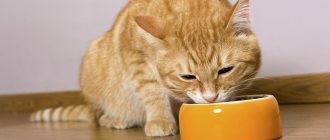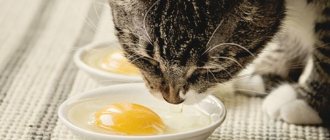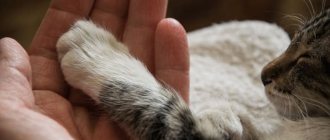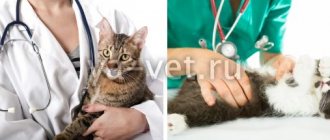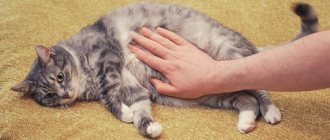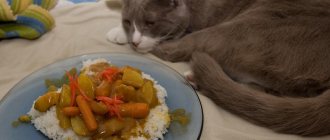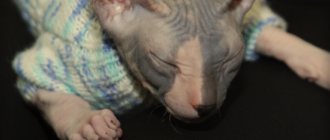Cats, like humans, can suffer from urinary tract diseases. Older pets, as well as after castration, are especially susceptible to them. Urological syndrome and urolithiasis are manifested by difficulty urinating, increased frequency, the appearance of blood in the urine, and pain. Kotervin for cats will help prevent and cure pathologies of the urinary system.
Let's study the composition and mechanism of action of the drug, as well as the features of its use.
Purpose of the drug
The drug "CotErwin" for pets has a mild diuretic effect, has stone-dissolving and salt-removing properties. Veterinarians prescribe this drug to animals to prevent the appearance and development of inflammatory processes. The drug, completely absorbed by the pet’s body, does not have cumulative, embryotoxic or teratogenic properties, due to which it has proven itself in the treatment of urolithiasis and cystitis, as well as urological syndrome.
Having pronounced diuretic properties, as well as promoting the removal of salts and dissolution of stones, the drug "CotErvin" is characterized by a lack of effectiveness against oxalates, which must be taken into account when prescribing this drug.
About the drug Kotervin and its areas of application
The drug is actively used not only in the treatment of various diseases of furry purrs, but also for prevention. The great advantage of the drug is its herbal composition, which has a gentle effect on the body.
Natural components make it possible to use the medicine even for cats with special sensitivity. In addition, the advantages of KotErvin include low pricing, efficiency and convenient release form.
The liquid has a herbaceous aroma and is yellowish in color. When stored in vials, sediment occurs, so shake the liquid before use.
KotErwin is actively used for:
- diseases of the excretory system;
- kidney stones;
- for the prevention of diseases of the urinary system.
The drug helps slow down the progression of diseases. It is not filled with dyes and preservatives and is made on the basis of:
- bird knotweed;
- water;
- steelweed root;
- horsetail.
Medicinal properties of the drug and indications for use
The use of KotErwin promotes:
- removing salt accumulations from the body;
- dissolving stones;
- relieving the inflammatory process in the body;
- occurrence of a diuretic effect.
The drug has a mild effect on the body due to the presence of natural components in the composition. The use of KotErwin cannot cause allergic reactions or harm the health of your pet, since the healing liquid is absorbed by the body. The drug does not have the following properties:
- cumulative type;
- embryotoxic;
- teratogenic.
The medicinal properties of KotErwin make it possible to effectively treat cats with urolithiasis and urological syndrome.
Composition and release form
The drug "CotErvin" is an aqueous remedy extracted from highly effective medicinal plants. The product is in the form of a yellowish-brown liquid and has a light and rather pleasant, specific herbal odor. The composition of this drug is presented:
- steelweed root - a component containing tannins and a whole range of organic acids that normalize the tone of smooth muscles, increase diuresis, and also have a fairly pronounced analgesic effect;
- knotweed and knotweed, which have approximately the same properties, which is due to the tannins, vitamins, flavonoids, and silicic acid they contain. Such components have an anti-inflammatory and diuretic effect, strengthen capillary walls well, and also ensure the removal of stones from the body;
- horsetail, rich in flavonoids, containing water-soluble forms of silicic acid and triterpene saponites. This component of the veterinary drug has a pronounced anti-inflammatory effect, promotes the passage of urine, and is also characterized by a hemostatic effect.
The standard composition of the drug includes 1.5% steelweed root, 0.5% horsetail, 0.5% knotweed and 1.5% knotweed herb, as well as 96% distilled water. During storage of a veterinary product, a characteristic and completely natural sediment may form at the bottom of the bottle. The medicine is sold packaged in 10 ml glass bottles, packed in three bottles, equipped with a convenient dropper cap, in standard cardboard boxes.
In order to preserve the therapeutic characteristics of the drug, the veterinary drug "CotErwin" should be stored in a dry, cool, dark place at a temperature within 12-25 ° C.
Description
Trade name of the drug: Kotervin® (Kotervin).
International non-proprietary names: knotweed grass, horsetail grass, knotweed grass, steelhead roots.
Dosage form: sterile infusion for oral use. It is a liquid from light yellow to brown; during storage, sediment may appear, which, when shaken, breaks down into a light, uniform cloud.
Kotervin® is a herbal medicine intended for the prevention and treatment of urinary tract diseases in cats:
- feline urological syndrome;
- urolithiasis disease;
- cystitis.
It has salt-removing, stone-dissolving (except oxalates), diuretic and anti-inflammatory effects.
The drug KOTERVIN® has also proven its effectiveness in the treatment of urolithiasis in dogs.
Instructions for use
For prophylactic purposes, as well as to prevent relapses of diseases, the veterinary drug is administered orally, based on the calculation of 2-4 ml per adult animal once a day, for one week. The standard therapeutic course can be repeated quarterly. At the initial stage of the disease, the veterinary drug is given to the pet 2-4 ml twice a day. The administration of the drug must necessarily be supplemented by the use of symptomatic treatments prescribed by a veterinarian.
In the treatment of diseases accompanied by the appearance of blood or its traces in the urine, as well as high specific gravity and increased urine pH, the veterinary drug is prescribed at a rate of 2-4 ml twice a day. The absence of spontaneous urination requires additional administration of the drug into the bladder through a puncture or using a catheter. The simultaneous administration of intramuscular injections of the drug "Neoferon" allows you to relax the urinary tract, eliminate the inflammatory syndrome and get rid of possible concomitant infectious lesions.
The veterinary medicinal product "KotErvin" does not contain preservatives, so its use requires compliance with basic recommendations. During administration into the bladder, in order to prevent contamination, the required amount of the drug is taken from the bottle strictly using a syringe with a sterile needle. When prescribing oral administration, it is necessary to uncork the bottle, then tightly place a special dropper cap on its neck and introduce the product into the animal’s oral cavity by pressing the pipette three times.
The drug remaining after use should be stored in the refrigerator for no more than seven days, without removing the dropper cap from the bottle, and immediately before the procedure, the product must be heated to body temperature and shaken vigorously several times.
KotErwin for cats - reviews
Owners of felines quite often use a drug with a natural composition and leave reviews about it, trying to reflect all the advantages and disadvantages of the herbal infusion.
Angelina
I know from my own experience how difficult it is to treat urolithiasis in cats. That is why I started giving my second pet drops of KotErwin from the age of 9 months for preventive purposes. The veterinarian advised, in addition to herbal medicine, to adjust the diet to avoid obesity, control the drinking regime and under no circumstances give the fluffy fish any fish. I really like KotErvin, because my cat drinks it with pleasure, and the price is quite affordable.
Elena
My cat is already 16 years old. For 8-9 years I have been giving KotErwin several times a year for prevention. One package contains several bottles, a cap (easy to put on, but difficult to remove) and a bottle opener. My purr feeds on economy food and periodically walks outside in any weather. There were no problems with the genitourinary system. The drug was well tolerated and did not cause us any side effects.
Alexander
My pet recently became ill with urolithiasis. How much pain and torment they experienced. After the examination, the veterinarian placed a catheter and prescribed infusions into the bladder of KotErwin. He told me how to give the drops. I also periodically poured in water using a syringe, since the fluffy stopped drinking on its own. With the help of a herbal preparation I was able to get rid of the catheter quite quickly. Gradually, the pet's health returned to normal. Now I will give drops to my pet every 3 months for preventive purposes.
Precautionary measures
The herbal veterinary product supplied by a well-established domestic veterinary product does not fall into the category of dangerous drugs. At the same time, manipulations with the drug "CotErvin" require obligatory adherence to the general rules of personal hygiene and standard safety precautions that are provided for when working with such veterinary drugs.
Due to the absence of toxic components and preservatives in the composition, even pet owners with a history of allergic reactions to chemicals or dyes can work with KotErvin.
Contraindications
The peculiarities of the composition of the herbal product reduce the presence of contraindications to the use of the drug "CotErvin" to zero. At the same time, experienced veterinary specialists note that with the judicious use of this drug according to the instructions supplied by the manufacturer, the appearance of any side effects is not provoked.
However, in extremely rare cases, the herbal components of this drug may well cause the development of allergic reactions in an animal. According to veterinarians and the manufacturer, the most important contraindication to the use of the drug "CotErwin" is severe renal failure in a four-legged animal.
The main contraindications for prescribing the herbal veterinary drug "CotErwin" also include the presence in the pet's history of evidence of increased individual sensitivity to the components of the drug.
Side effects
The drug, which does not have embryotoxic properties and does not have a cumulative effect, usually does not cause side effects during use. In some cases, there is lacrimation, profuse nasal discharge, as well as a burning and itching sensation, which is accompanied by scratching of varying degrees of intensity. When your pet shows the first signs of side effects, it is recommended to choose a replacement for the drug “CotErvin”.
Today, the best analogue of the drug “CotErwin” is recognized as the veterinary drug “Stop-cystitis”, made on the basis of medicinal herbs and containing simple plant components, represented by knotweed, licorice root, as well as juniper fruits, nettle and lingonberry leaves.
Cost of KotErwin
The veterinary drug, which has a pronounced saluretic, as well as diuretic and anti-inflammatory effect, is recommended to be purchased strictly in stores specializing in the sale of medicines. The drug "CotErvin" must be supplied with official instructions for use.
Today, the average cost of a veterinary medicinal infusion for oral use, packaged in bottles with a total volume of 10 ml, can vary between 145-155 rubles (for one package containing three bottles).
Reviews about KotErwin
The veterinary product "CotErvin" has been tested and approved by veterinarians, and among other things, has numerous positive reviews from cat owners. The product is very convenient to use. The solution is applied to the oral cavity by pressing the pipette three times or poured into a teaspoon, after which it is given to the pet. You can add the medicine not only to drinking water, but also to milk. The effectiveness of the phytocomplex allows the drug to be prescribed to cats with different degrees of pathology, as well as representatives of the Persian breed who have a genetic predisposition to the occurrence of urinary tract diseases.
The remedy is effective in cases of diseases caused by disturbances in the water-salt balance, as well as disruptions in the acid-base balance of the blood lymph. Sometimes problems in a pet's health arise as a result of feeding habits and the lack of a balanced diet with a predominance of protein foods and a lack of the most important carbon-containing components. The veterinary drug "CotErwin" can also be used for prophylactic purposes in case of excessive feeding of a pet with fish or insufficiently high-quality dry food belonging to the "economy class" category.
Experienced veterinarians strongly recommend using such a herbal medicine if the pet drinks a minimal amount of water, which causes a significant increase in urine concentration. The use of the drug “CotErvin” gives very good results in case of a lack of vitamins D and A, as well as in case of a sedentary lifestyle and in conditions of early castration of cats, before they reach sexual maturity. In some pets, the prescription of a veterinary drug may be due to excess weight or the presence of a streptococcal or staphylococcal infection in the body.
Negative reviews about the use of the veterinary drug "CotErvin", as a rule, are associated with errors in prescription and non-compliance with the treatment regimen. It is very important to strictly adhere to all doctor’s recommendations and not to deviate from the total duration of the course of therapy, which is indicated in the instructions supplied by the manufacturer with the drug. In this case, any side effects caused by an allergic reaction to some of the active herbal components included in the KotErvin product are extremely rare in pets.
Tactics for using uroseptics in general practice
To this day, uroseptics remain the main means of pathogenetic therapy for urinary tract infections. The most important way to increase the effectiveness of treatment is not only the creation and implementation of new uroantiseptics, but also improving the tactics of using existing agents. Drugs that are classified as uroseptics are summarized in Table. 1.
Table 1. Pharmacological drugs related to uroseptics
— oxolinic acid (gramurin) — cinoxacin (cynobac) — nitroxoline (5-NOK) — nalidixic acid (nevigramon, negram) — pipemidic acid (palin, pimidel, pipem) — nitrofural (furacilin) — nitrofurantoin (furadonin, nitrofurantoin) — nifuratel (macmiror) - nifurtoinol - furazidin (furagin) - furazolidone (furazolidone) - methenamine (uroflux) - trimethoprim (trimopan, triprim) |
The problem of optimal choice of uroseptic in the treatment of a particular patient dictates the need to answer many questions. First of all, it is necessary to find out the localization of the urinary tract infection, determine the type of pathogen and its sensitivity to the selected uroseptic, the severity of the inflammatory process, and the functional state of the kidneys. In addition, it is necessary to have a clear understanding of the pharmacokinetics and pharmacodynamics of the drug.
Only after answering these questions does the choice of drug become truly optimal.
Speaking about the localization of infection, we must not forget that even the same patient may have different microflora in the kidney parenchyma and in the urinary tract.
As a rule, in the early stages of the disease, a monoinfection is detected; with a longer course of the process, in the case of inadequate antibacterial therapy, microbial associations appear, including up to two or three types of pathogens, often both gram-negative and gram-positive.
The most common pathogens are Escherichia coli and enterococci (i.e., obligate intestinal flora), as well as the hemolytic variant of Escherichia coli, Proteus, Pseudomonas aeruginosa, Staphylococcus aureus, and Klebsiella. Moreover, associations of various types of pathogens with pyelonephritis occur in 20-45.5% of cases. In approximately 15% of cases of chronic pyelonephritis, it is not possible to identify the pathogen in the usual way, either in urine cultures or in cultures of renal tissue. Pathogens that have transformed into forms lacking cell walls (L-forms) and mycoplasmas require complex diagnostic media and techniques for their detection.
Identification of the pathogen allows you to select the most effective uroseptic. Currently, there are clear recommendations on the choice of uroseptic depending on the pathogen, and there is a lot of information on this issue in the literature. In situations where urine culture and flora sensitivity results cannot be expected, standardized antibacterial regimens may be used. For example, it is possible to use gentamicin, if necessary in combination with cephalosporins, or a combination of carbenicillin (pyopene) with nalidixic acid, colymycin with nalidixic acid.
Currently, in severe forms of urological infection - pyelonephritis, urosepsis, in case of resistance to other classes of antimicrobial substances, in the presence of multiresistant strains of bacteria - it is recommended to use fluoroquinolone antibiotics.
If it is necessary to carry out therapy with uroseptics for a long time, with changing drugs every 7-10 days, it is advisable to consistently use drugs that act on the bacterial wall and on the metabolism of the bacterial cell. Sequential use of penicillin and erythromycin, cephalosporins and chloramphenicol, cephalosporins and nitrofurans is recommended to prevent the survival of protoplast and L-form bacteria.
All of the listed groups of uroseptics penetrate well into the tissues of the genitourinary system and urine, where concentrations sufficient to obtain a therapeutic effect are created. At the same time, checking the excretory function of the kidneys is mandatory in each case. With pronounced sclerotic changes and damage to the glomerular apparatus of the kidneys, the success of treatment decreases, and when glomerular filtration decreases to 30 ml/min, there is no point in carrying out antibacterial therapy, since it is impossible to obtain a therapeutic therapeutic concentration of drugs in the renal parenchyma. In addition, the risk of developing toxic effects increases sharply. A decrease in the functional capacity of the kidneys forces us to pay special attention to the nephrotoxicity of the drugs used.
Fluoroquinolones, oxacillin, methicillin, carbenicillin from the penicillin group, macrolides, cephalosporins, and chloramphenicol have virtually no nephrotoxic effects.
Ampicillin, lincomycin, nitrofurans, nalidixic acid, and some long-acting sulfonamides have slight nephrotoxicity. In the presence of renal failure, tetracyclines become nephrotoxic. Aminoglycosides (gentamicin, streptomycin, torbamycin, kanamycin) are always highly nephrotoxic.
The nephrotoxic effects of the drugs are enhanced by severe dehydration and while taking diuretics.
One of the most important criteria for choosing a drug is urine pH. Aminoglycosides and macrolides exhibit maximum effectiveness in an alkaline environment at pH = 7.5–9.0; as urine pH decreases, their activity decreases. The effectiveness of cephalosporins, fluoroquinolones, glycoproteins, tetracyclines, and chloramphenicol does not depend on urine pH. In an acidic environment at pH ≤ 5.5, penicillins, derivatives of naphthyridine, nitrofuran, quinolone, 8-hydroxyquinolone, and metepamine are most effective. All these drugs significantly reduce their activity as the environment becomes alkalized.
In order to increase the alkalinity of urine, it is possible to prescribe a dairy-vegetable diet and sodium bicarbonate. To reduce the pH of urine (acidify it), increase the consumption of bread and flour products, meat and eggs. Ammonium chloride, ascorbic acid, methionine, hippuric acid (which is found, for example, in cranberry juice) are prescribed. Any substance that reduces urine pH below 5.5 inhibits the development of bacteria in the urine.
In the presence of microbial associations, it is possible to use a combination of two uroseptics.
Fluoroquinolones have good compatibility with most antimicrobial drugs and the absence of adverse reactions during combined antibacterial therapy.
β-lactams (penicillins, cephalosporins), aminoglycosides and polypeptides have a synergistic effect and can be combined in severe forms of infection. Moreover, all of the listed groups of antibiotics exhibit antagonism when interacting with tetracyclines, macrolides, and lincomycin.
Levomycetin, tetracyclines and macrolides show indifference when prescribed together. Nitrofurantoin weakens the effect of nalidixic acid. It is considered inappropriate to prescribe the following combinations: furagin with chloramphenicol, furagin with sulfonamides, chloramphenicol with sulfonamides, methenamine with sulfonamides.
Both the choice of drug combination and the required duration of course therapy and the route of drug administration depend on the location of the infection, the severity of the process, and the pathogen.
Doses of drugs for course therapy are given in table. 2. When carrying out treatment, it should be remembered that resistance of microorganisms develops to some drugs. This should be especially taken into account if intermittent therapy is necessary. Preference should be given to drugs to which resistance develops relatively slowly: these are fluoroquinolones, ampicillin, chloramphenicol, depot sulfonamides. Resistance to furagin develops especially slowly, so this drug is the most important when carrying out long-term intermittent treatment.
Resistance of microorganisms to nalidixic acid, oxolinic acid, tetracyclines, streptomycin, and cephalosporins develops quite quickly and often.
Given the above, you should always find out which drugs were used in previous therapy and evaluate the degree of their effectiveness.
It is also necessary to clarify the side effects that occurred during previous therapy and take into account the possibility of their occurrence during the treatment.
All of the above indicates that even with a mass of recommendatory literature with a large number of different treatment regimens, the approach to the treatment of urinary tract infections cannot be mechanical and requires an individual choice of treatment tactics for each specific patient.
Literature
- Padeiskaya E. N. The importance of fluoroquinolones in the treatment of urinary tract infections // Breast Cancer. No. 10. P. 477-478.
- Bertrand G., Katzung. Basic and clinical pharmacology. T. 2.
- Barkhanova A. G., Zakharova G. Yu. Use of antibacterial drugs in chronic pyelonephritis. Tutorial. Moscow, 1977. P. 23.
- Nephrology in 2 vols. edited by I. E. Tareeva.
Questions that a general practitioner should answer when choosing a uroseptic
- At what pH of the environment is the uroseptic effect optimally realized?
- What is the possibility of the combined use of uroseptics, their interactions, synergism or antagonism of action?
- What is the required duration of course therapy to obtain the best effect?
- How quickly does drug resistance develop?
- What is the most appropriate route of administration of the drug?
- What is the optimal dose needed to treat a particular patient?
- What is the nephrotoxicity of uroseptic?
- What are the possible side effects?
